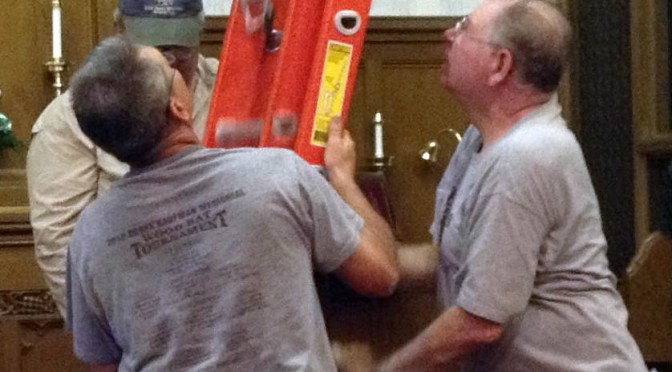We recently celebrated a renewal of ministry as we welcomed the Bishop back in our midst. It was a fun service, geared toward the ministry we all do together: proclaiming the Good News, serving the poor, working for justice in our context, and much more.
Some found the timing curious. Some were interested in what this meant for the relationship between St. Paul’s and me. Some have wondered on the back end of the process what could have happened on the front end. That’s all reasonable. I want to share with you something that might make it easier to understand our process and how that might differ from one’s personal experience.
From it’s founding in the 18th Century, the Episcopal Church has striven to live in and separate from two worlds. We wanted to take the best of a hierarchical structure and the best from a democratic one and leave behind the nasty parts of each. We’re going over this in Basics this week and next, actually, so you should join us on Wednesday night at 6:30 pm! Because our origin is not directly from the Church of England, which is very hierarchical, but from the Scottish Episcopal Church, which is much more democratic, we have a blend of both.
In the Episcopal Church we have a polity (organization) that is based around bishops and congregations. We serve our bishop but operate with much autonomy. The clergy serve the bishop and congregations help determine who best to partner with in ministry. This is in stark contrast to our Roman Catholic friends who operate under the total prerogative of the Bishop and our Baptist friends whose clergy is entirely chosen by the local congregation. There are upsides and downsides to both. Our process tries to maximize the upside and minimize the downside. In fact, all three parties get a say in this arrangement: the bishop, the congregation, and the clergy. This is a pretty unique process in the global church and even within the Anglican Communion.
This means that we don’t operate in a democracy. Nor do we live in a banana republic. And there are many cases in which our tendency to lean toward congregationalism prevents us from benefiting from the wisdom an outside presence can offer. As the bishop said to us, his judgment was that a “normal” transition process wasn’t going to work here. My personal experience says that a new “normal” is forming around this as we speak. I’ve seen churches refuse to grieve the departure of a rector, bury their faults as deeply as possible, refuse to do the visioning work necessary to make a successful call, or who reject the interim process all together. All these actions have led to serious conflicts in many churches as unresolved issues spring up shortly after the new rector is called. Many churches are having a hard time with this process and want a different one to replace it.
For the last eight months we’ve been operating in one such alternative process. A process that has allowed us to do some difficult transition work together while also getting started on a more natural vision process. A process that isn’t putting an airbrushed picture of who we wished we were, but honestly wrestling with who we are so that we can learn who we want to be. This is a process that I’m committed to and a process that has been open to all from day one. On that first Sunday, I invited everyone to name their talents, to say what our gifts are and how we might share them, so that we might all take part.
This brings me back to that service from a week ago. A service that used to be called an “installation” service. A service that once had the tone of a Superman swooping in to save a congregation or of a vanquishing hero coming to lead an army. This service was adapted a few years ago to be about the ministry we are sharing. The ministry that we are doing together. A ministry we were called to do when we were baptized. A ministry we all committed to again. A ministry confirmed by the sprinkling of water as the Bishop and I doused the congregation.
A ministry we are being called to do together right now.


Leave a Reply